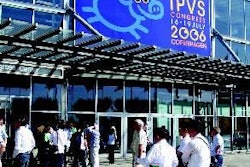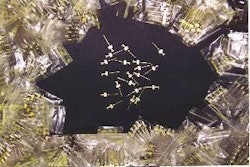
Lift-up farrowing crates are a fairly common sight on sow herds in Denmark. At a unit in the west of the country, however, they feature in a housing arrangement that is so unusual it is called almost unique among Danish piglet-producing sites. Crates in this unit's farrowing places near the town of Aars swing clear of the floor to allow the piglets to stay in the same pen until they are ready for transfer at 35 kilograms liveweight.
These birth-to-35kg pens have been installed by Frans Nyrup Pedersen, whose herd of 750 sows sells weaners to a nearby finishing enterprise. The central logic behind their design is that pigs should not be moved when they are weaned. According to Henrik, eliminating this source of extra stress on the young pig avoids the loss of 3-4 days of growth after weaning. His pigs reach 35kg faster and fitter for the fact they suffer no movement-related growth check along the way.
"We started by taking them to 30kg," he comments. "It worked so well that we have been able to change the sale weight from 30kg to 35kg in the last few months."
Of course, there are some comparative costs to be assessed in deciding whether the same-pen regime is justified. Buy a farrowing crate of the type used on Mr Nyrup Pedersen's unit and you would be likely in Denmark to pay approximately DKK1700 per place for the steelwork alone, without any other equipment included. But he argues that this represents the main additional expense compared with the more conventional Danish routine of moving weaners to a so-called climate-pen nursery. The pen sizes are virtually identical in square metres of total area.
On the basis that the number of pig-places required would be the same in either type of accommodation, therefore, the real comparison is of the choice between either buying a lift-up crate for every pen or equipping them as nurseries in the conventional way. Frans calculates the total difference for his herd at about DKK750 000 (US$126 7300). This covers the extra equipment in providing 384 farrowing pens, approximately twice as many as in a conventional system. It equates to around DKK2000 per pen. By the time he has deducted the expenditure he would have needed to make on a normal nursery arrangement, however, the added cost works out only at DKK1500 per pen.
To balance against that extra outlay he has the value of the weight gains obtained during the days when moved pigs would still be going through a growth check. There is more uniformity, too, he argues. Further benefits include the obvious points that pens are occupied more often and washing is a less frequent chore. On calculations by Mr Nyrup Pedersen, washing duties now involve just 0.75 days per week instead of a previous 2 days/week.
Flexibility is emphasised at least as much as the other advantages. Take the occasional sow that farrows up to 3 or 4 days later than expected, Frans remarks. In this system, she can be left for an extra week if that seems desirable. Similarly it is even possible to wean a sow from a later batch to make up the right number for mating, provided that her piglets are the right size. At holiday times there is the option of emptying a section early if its pigs weigh about 30kg so that the following week has relatively little work.
Although other producers in Denmark remain to be convinced, Frans remarks, they are taking a keen interest in his experiences. The doubters among them are soon reminded that the underlying principle is hardly new. Years ago, it was customary for herds in this country to use the farrowing box to hold litters for the first days or 1-2 weeks after they were weaned. A design to take pigs from birth to 35kg is essentially the same system except for modern equipment and an extension of the housing period to cover 4-5 weeks from the weaning date. Frans Nyrup Pedersen is convinced that this latest version soon pays for itself in kilograms gained.

















